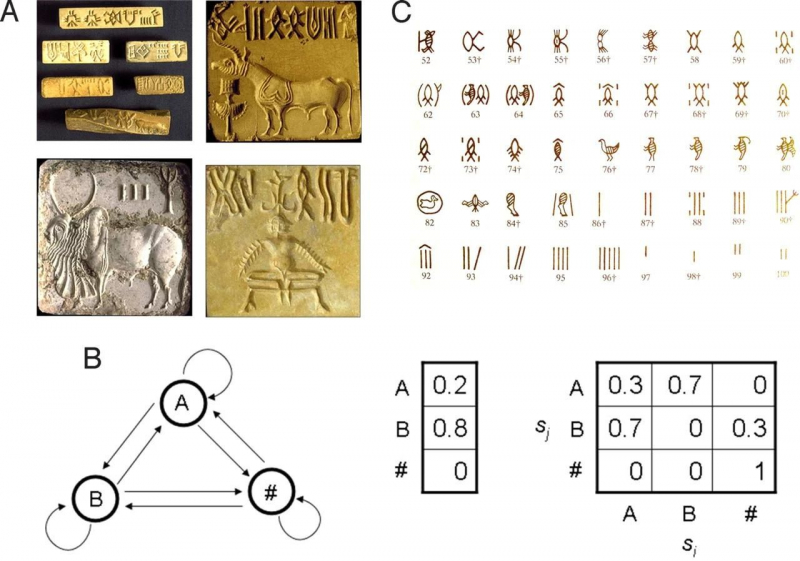Top 5 Interesting Facts About Indus Script
During the Harappan City excavation, Indus Script was found. It also goes by the name of Harappan Script. It is made up of a relatively small number of signs ... read more...and symbols without underlying language or multilingual inscriptions. The majority of the signs and symbols found in the script were in use between the 26th and 30th centuries B.C.E., which is known as the Mature Harappan period. For a variety of reasons and facts, the Script is viewed as a remarkable discovery made by the Indus Valley civilization. The 5 most interesting facts about the Indus Script are listed below in some detail.
-
The Indus Script, the earliest known writing system in the Indian subcontinent, was created by the Indus Valley Civilization, which is one of the most interesting facts about the Indus Script. It is unclear where this writing system came from, no consensus exists over the language it represents, no bilingual documents have been discovered yet, and its relationship to authentic Indian writing systems (such as Brahmi, Devanagari, and Bengali script) is also unclear. The Indus Valley Civilization is one of the lesser knowns of significant early civilizations of antiquity because of this.
The oldest known examples of Indus Script signs, attested on Ravi and Kot Diji pottery excavated at Harappa, date to the early Harappan phase (3500-2700 BCE). These samples show an early stage in the creation of the Indus Script because only one symbol is visible on the clay surface. Longer inscriptions from the Urban period (2600–1900 BCE), when it reached its peak of development, are known. From approximately 60 excavation sites, thousands of inscriptions have been discovered; the majority are brief, with an average length of five characters and no inscription exceeding 26 signs.

Photo: https://www.businessinsider.com/ 
Photo: https://www.khanacademy.org/ -
Seals impressions, pottery, bronze tools, stoneware bangles, bones, shells, ladles, ivory, and tiny tablets made of steatite, bronze, and copper have all been discovered to contain examples of Indus writing. The primary form of Indus Script is square stamp seals, which are typically an inch square (2.54 cm), with the script itself, displayed on top and an animal design in the center. There are examples of seals made of silver, faience, and calcite, although they are typically constructed of steatite. Some of them also include a layer of smooth material that has a glassy appearance. To reproduce the seals' image, clay or another flexible surface was used to press the seals.
Since the Indus Script has not yet been deciphered, its purpose cannot be determined with certainty, and all knowledge is dependent solely on archaeological data. Some of the seals may have served as talismans or amulets, but they also served as a useful means of identification. It is also thought that the Indus Script was employed as a management tool, given that writing in ancient times is typically connected with elites attempting to record and govern transactions. As evidence of how far things went in ancient times, there are also examples of this script being employed on clay tags affixed to bundles of products that were transferred between merchants. Some of these clay tags have been discovered in Mesopotamia, far from the Indus Valley.
The Indus Script was also employed in the context of "narrative imagery," which consisted of scenes from tales or stories that the script was coupled with pictures of real or imagined people, animals, or other beings in dynamic stances. This final application is comparable to the well-documented religious, liturgical, and literary uses in other writing systems.

Photo: https://www.khanacademy.org/ 
Photo: https://www.britannica.com/ -
The Indus Script, the earliest script used by the Indus Valley Civilization, was written using a variety of signs and symbols. It is poorly understood and has not yet been decided.
The majority of the Indus Script, according to the scholars, was inscribed on perishable materials like birch or palm leaves, neither of which survived the ravages of time. This shouldn't come as a surprise given that bamboo tubes, birch trees, and palm leaves were frequently employed in the south and southeast Asia as writing surfaces. According to some experts, the 400 symbols can be reduced to 39 basic signs, with the other symbols consisting mainly of stylistic variances and scribe-to-scribe discrepancies.
Despite what academics claim, there is still no proof that the script was deciphered in the 1980s. As a result, if the symbols present in this script are separated and deciphered using close analogies with Sumerian, Egyptian, and Ancient Chinese, it may provide some insight. Asko Parpola, one of the world's leading experts, has been researching it for more than 40 years at the University of Helsinki in Finland.

Photo: https://loessground.blogspot.com/ 
Photo: https://media.springernature.com/ -
Scholars have been unable to solve the riddle of the Indus Script for several reasons. The recovery of bilingual inscriptions, or comparing an unknown script with a known one, allowed for the initial decipherment of some ancient languages, including Egyptian. Unfortunately, no bilingual inscriptions have yet been discovered, preventing comparisons between the Indus Script and other writing systems.
The fact that all of the inscriptions discovered so far are relatively brief, with less than 30 signs, presents another challenge to their decipherment. As a result, it is impossible to correctly analyze recurrent sign patterns, another method that can be used to reveal the meaning of a writing system, for the Indus Script.
The language (or languages) that the Indus Script is thought to represent is still unknown, which is the final and most significant reason why it hasn't been deciphered. The two language families that are most frequently preferred by academics are Indo-European and Dravidian, but other options have also been put forth, including Austroasiatic, Sino-Tibetan, and maybe a lost language family. Numerous academics have proposed that the Indus Valley Civilization was not Indo-European based on the material culture connected with it.

Photo: https://www.thearchaeologist.org/ 
Photo: https://brewminate.com/ -
The majority of academics who have researched the Indus Script concur on several issues, even though its decipherment has not yet been accomplished.
Typically, the Indus Script was written from right to left. In the majority of instances, this is true, but there are few exceptions in which the writing is bidirectional, i.e., it moves in one direction on one line but in the other direction on the following line.
It has been determined how specific numerical values are represented. A downward stroke was used to symbolize a single unit, and semicircles were used to denote units of 10.
The Indus Script blended phonetic value with word marks and symbols. A "logo-syllabic" writing system is one in which some symbols represent sounds and others indicate concepts or words. This opinion is supported by the discovery of 400 or so signs, making the idea that the Indus Script was purely phonetic improbable. The Indus Script, however, might only be phonetic if the theory that the hundreds of signs can be condensed to just 39 is accurate.

Probabilistic analysis of Indus Script - Photo: https://www.harappa.com/ 
Photo: https://www.pnas.org/


























